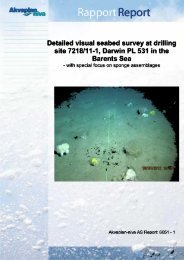A study of the priority substances of the Water Framework Directive ...
A study of the priority substances of the Water Framework Directive ...
A study of the priority substances of the Water Framework Directive ...
You also want an ePaper? Increase the reach of your titles
YUMPU automatically turns print PDFs into web optimized ePapers that Google loves.
..:::::::::: hexachlorocyclohexane (HCH)<br />
..:::44<br />
18 Hexachlorocyclohexane (HCH)<br />
� HCH is a pesticide which in its raw form as<br />
insecticide against grasshoppers, lice and mites<br />
in buildings.<br />
� HCH consists <strong>of</strong> alpha, beta and gamma and<br />
delta isomers. The gamma isomer is Lindane.<br />
The alpha and beta isomers are usually byproducts<br />
from production <strong>of</strong> Lindane. This fact sheet<br />
covers alpha, beta and delta isomers. Lindane is<br />
covered in an own fact sheet.<br />
� There is no registered use in Norway, and low<br />
levels <strong>of</strong> HCH in <strong>the</strong> environment.<br />
� No fur<strong>the</strong>r screening or monitoring <strong>of</strong> HCH<br />
is considered necessary.<br />
Production and use<br />
HCH has usually been a by-product in Lindane<br />
production. The alpha isomer is normally constitutes<br />
70 % <strong>of</strong> HCH, beta is up to 10 percent<br />
while <strong>the</strong> rest is gamma (and delta) isomer and<br />
o<strong>the</strong>r <strong>substances</strong>. HCH has sometimes been<br />
used as an independent insecticide, less effective<br />
but cheaper than Lindane. There is no registered<br />
use in Norway, but HCH isomers can be a<br />
degradation product <strong>of</strong> Lindane.<br />
Emissions, discharges,<br />
distribution and hot-spots<br />
Probable sources for HCH in Norwegian <strong>the</strong><br />
environment are transboundary air pollution<br />
and decomposition <strong>of</strong> Lindane.<br />
Monitoring<br />
HCH has been studied in several investigations,<br />
but <strong>the</strong>re are no time studies.<br />
Marine sediments<br />
In marine sediments, HCH isomers are investigated<br />
toge<strong>the</strong>r, at 24 localities along <strong>the</strong> coast.<br />
The levels are relatively low, <strong>the</strong> highest levels<br />
are found in Tyssedal in Sørfjorden in<br />
Hordaland County.<br />
Marine biota<br />
All HCH isomers are also investigated toge<strong>the</strong>r<br />
in marine biota. Horse mussels (Modilus modilus),<br />
blue mussels (Mytilus edulis), cod liver<br />
(Gadus morhua), peregrine falcon (Falco peregrinus)<br />
and gyrfalcon (Falco rusticolus) have<br />
been investigated. The highest levels are in falcons,<br />
but also <strong>the</strong>se levels are relatively low.<br />
A <strong>study</strong> <strong>of</strong> <strong>the</strong> <strong>priority</strong> <strong>substances</strong> <strong>of</strong> <strong>the</strong> <strong>Water</strong> <strong>Framework</strong> <strong>Directive</strong><br />
TA-2140/2005<br />
FACTS<br />
Cas no.: 608-73-1 (alfa 319-84-6, beta 319-85-7, delta<br />
319-86-8)<br />
Synonyms: Alpha-hexachlorocyclohexane (alpha-<br />
HCH), Beta-hexachlorocyclohexane (beta-HCH),<br />
Delta-hexachlorocyclohexane (delta-HCH).<br />
Properties: White/yellowish powder/flakes<br />
Toxic effects: Possible carcinogen. Slightly toxic.<br />
Alpha: acute oral LD50 rats between 500-4670<br />
mg/kg. Alpha-HCH has low toxicity for algae. Alpha-<br />
HCH is moderately toxic for invertebrates and fish.<br />
Beta: LD50 rats from 1500 mg/kg (8 g/kg body weight<br />
for rats (neurological intoxication)). Beta-HCH generally<br />
has moderate toxicity for algae, invertebrates<br />
and fish and weak estrogenic effect on rats.<br />
Delta: LD50 rats 1000mg/kg<br />
Log Kow: Alpha: 3,8; Beta 3,78; Delta 4,14<br />
Persistence: Alpha: half-lives <strong>of</strong> 125 and 48 days<br />
under aerobic and anaerobic conditions, respectively.<br />
Beta is <strong>the</strong> most persistent isomer with half-life up<br />
to 122 days in soil (calculation). O<strong>the</strong>r tests show<br />
higher persistence. HCH may convert to o<strong>the</strong>r isomers.<br />
Adsorbs to suspended solids and sediment in<br />
<strong>the</strong> water column. High to very high potential for<br />
bioaccumulation.<br />
<strong>Water</strong> solubility: Alpha 2 mg/l 28°C; Beta 0,2 mg/l<br />
25°C; Delta 31,4mg/l 25°C<br />
Molecular formula: C 6 H 6 Cl 6<br />
Metabolites: Alpha delta-3,4,5,6-tetrachloro-hexene<br />
and pentachlorocyclohexene, urinary metabolite is<br />
2,4,6-tri-chlorophenol.<br />
Fresh water sediments<br />
�-HCH and ß-HCH were investigated in sediments<br />
in several lakes in Nordland, Troms and<br />
Finnmark. Only �-HCH was found, in low concentrations.<br />
Fresh water biota<br />
Pike liver (Esox lucius), perch liver (Perca fluriatilis)<br />
and roach liver (Rutilus rutilus) in three<br />
lakes in Eastern Norway were investigated. �-<br />
HCH was found in low concentration in one<br />
pike liver.

















